Pandas系列进行排序
系列是一个一维标签数组,能够容纳整数、字符串、浮点数、Python对象等类型的数据。轴的标签被统称为索引。
现在,让我们看看一个对Pandas系列进行排序的程序。
对于pandas系列的排序,可以使用Series.sort_values()方法。
语法: Series.sort_values(axis=0, ascending=True, inplace=False, kind='quicksort', na_position='last')
例子1:以升序对数字系列进行排序。
# importing pandas as pd
import pandas as pd
# define a numeric series
s = pd.Series([100, 200, 54.67,
300.12, 400])
# print the unsorted series
s
输出 :
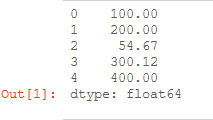
现在我们将使用Series.sort_values()方法对一个数字系列进行升序排序。
# sorting series s with
# s.sort_value() method in
# ascending order
sorted_series = s.sort_values(ascending
= True)
# print the sorted series
sorted_series
输出:
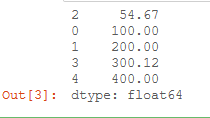
从输出结果中,我们可以看到,数字系列是按升序排序的。
例子2:以降序对数字系列进行排序。
# importing pandas as pd
import pandas as pd
# define a numeric series
s = pd.Series([100, 200, 54.67,
300.12, 400])
# print the unsorted series
s
输出:
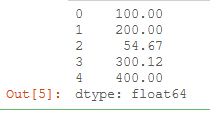
现在我们将使用Series.sort_values()方法对一个数字系列进行降序排序。
# sorting the series s with
# s.sort_values() method
# in descending order
sorted_series = s.sort_values(ascending
= False)
# printing the sorted series
sorted_series
输出:
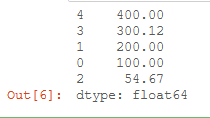
从输出结果中,我们可以看到,数字系列是按降序排序的。
例子3:对一系列字符串进行排序。
# importing pandas as pd
import pandas as pd
#d efine a string series s
s = pd.Series(["OS","DBMS","DAA",
"TOC","ML"])
# print the unsorted series
s
输出:
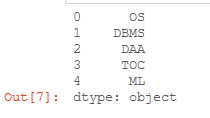
现在我们将使用Series.sort_values()方法对一系列的字符串进行排序。
# sorting the series s with
# s.sort_values() method
# in ascending order
sorted_series = s.sort_values(ascending
= True)
# printing the sorted series
sorted_series
输出:
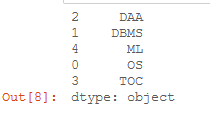
从输出结果中,我们可以看到,字符串系列是按词典上的升序排序的。
示例4:对数值进行就地排序。
# importing numpy as np
import numpy as np
# importing pandas as pd
import pandas as pd
# define a numeric series
# s with a NaN
s = pd.Series([np.nan, 1, 3,
10, 5])
# print the unsorted series
s
输出 :
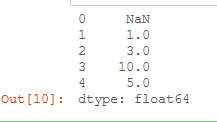
现在我们将使用系列.sort_values()方法对数值进行原地排序
# sorting the series s with
# s.sort_values() method in
# descending order and inplace
s.sort_values(ascending = False,
inplace = True)
# printing the sorted series
s
输出:

输出结果显示,Pandas系列中的原地排序。
例子5:对系列中的数值进行排序,把NaN放在前面。
# importing numpy as np
import numpy as np
# importing pandas as pd
import pandas as pd
# define a numeric series
# s with a NaN
s = pd.Series([np.nan, 1, 3,
10, 5])
# print the unsorted series
s
输出:

现在我们将使用Series.sort_values()方法对系列中的数值进行排序,将NaN放在首位。
# sorting the series s with
# s.sort_values() method in
# ascending order with na
# position at first
sorted_series = s.sort_values(na_position =
'first')
# printing the sorted series
sorted_series
输出:
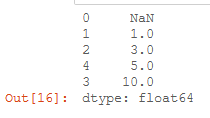
输出显示,NaN(非数字)值在排序的系列中被置于首位。
 极客教程
极客教程